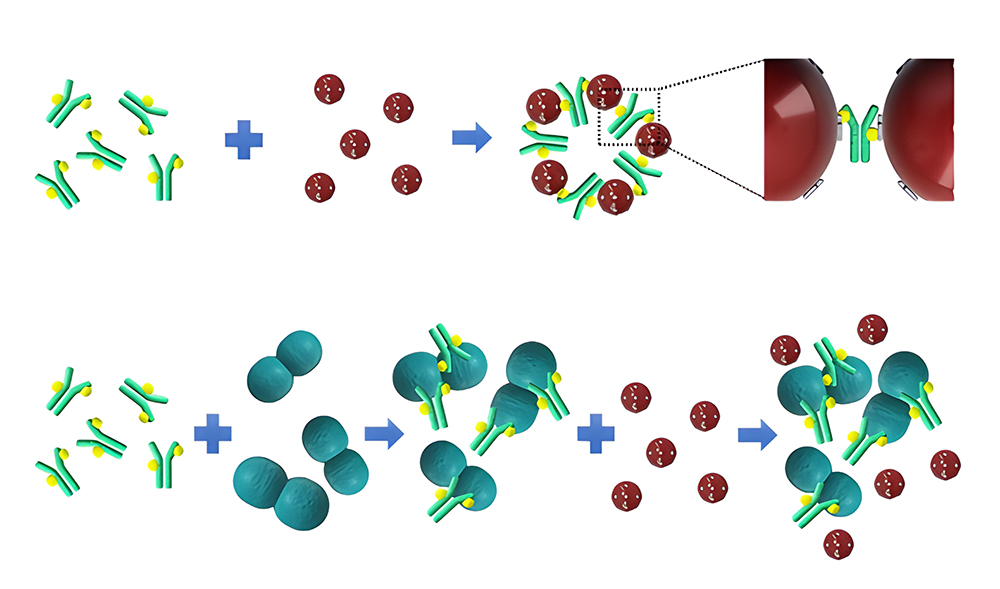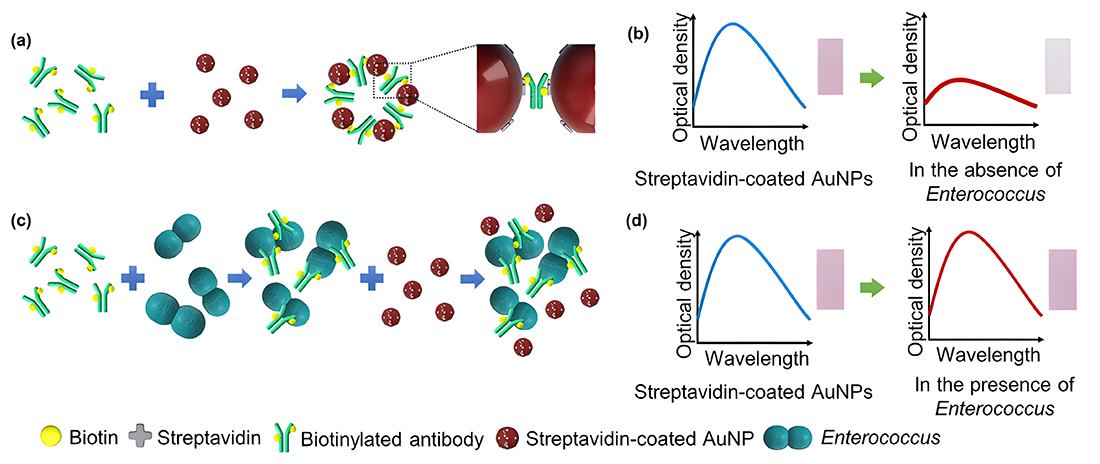
PNU 리서치
- 메인으로 이동
- 연구/산학
- PNU 리서치

미생물학과 이은희 교수팀은 환경 물질의 영향을 받지 않으면서 해수와 담수에서 분변 오염의 주요 지표로 활용되는 장구균(Enterococcus)을 선택적으로 검출할 수 있는 새로운 분석법을 개발했다.
‘장구균(Enterococcus, 엔터로코커스)’은 인간과 동물의 소화계에서 흔히 발견되는 미생물로, 해수와 담수를 포함한 다양한 수환경에서 분변(糞便) 오염의 주요 지표로 활용된다.
기존 Enterococcus 검출 방법으로는 미생물 생장 기반의 배양법, 유전자 분석 기반의 PCR, 색변화, 전기신호 변화를 이용하는 센서 등이 알려져 있다. 이러한 검출법은 높은 감도를 보이지만, 전처리와 배양에 시간이 소요되며 환경 내 다양한 물질로부터 영향을 받을 수 있다는 한계가 있다. 이러한 점에서 외부 환경 요인에 간섭을 받지 않으면서도, 전처리가 필요하지 않고 신속 정확하게 Enterococcus를 검출할 수 있는 새로운 방법 개발이 필수적이다.
이번에 개발된, 환경 물질의 간섭을 받지 않는 새로운 Enterococcus 검출법은 금 나노입자, 스트렙타비딘, 바이오틴화된 Enterococcus 항체 등을 사용한다. Enterococcus 검출은 금 나노입자의 응집 정도를 측정하는 방식으로 진행된다. Enterococcus가 존재할 경우, 스트렙타비딘과 바이오틴화된 항체 간의 상호작용이 억제돼 금 나노입자가 응집되지 않고, Enterococcus가 존재하지 않으면 금 나노입자가 응집되도록 설계됐다.
이를 통해 3시간 이내에 10-107 CFU/mL 범위의 Enterococcus를 측정할 수 있었으며, Escherichia coli와 같은 다른 장내 세균이 공존하는 조건에서도 Enterococcus만을 선택적으로 검출해 냈다. 실제 해수와 담수를 대상으로 한 조사에서도 다른 세포나 환경 요인에 의한 간섭은 발견되지 않았으며, 기존 Enterococcus 검출 표준방법과 유사한 결과를 보여 높은 신뢰성을 입증했다.

【간섭 저항성 금 나노입자 기반 장구군 검출법 모식도】
(a-b) Enterococcus가 존재하지 않을 때 반응 및 신호 변화 (c-d) Enterococcus가 존재할 때 반응 및 신호 변화
금 나노입자 기반의 측정법은 복잡한 전처리 과정 없이 빠르고 선택적으로 Enterococcus를 검출할 수 있어, 실시간 수질 모니터링에 적합하다. 또한, 해수 및 담수 환경에서 다른 세균이나 환경 물질에 간섭받지 않고 Enterococcus만을 선택적으로 검출할 수 있다는 점은 매우 실용적이다. 이번 연구결과는 수질 관리와 오염 감지 시스템의 효율성을 크게 향상시킬 수 있으며, 장기적으로는 공중 보건 향상과 환경 보호에 기여할 것으로 기대된다.
이은희 교수는 “수질 관리 및 공중 건강을 위해 신속하고 정확한 분변 오염 모니터링은 반드시 필요하다. 이번 연구는 다양한 환경 방해 인자가 존재하는 조건에서도 Enterococcus를 선택적으로 검출할 수 있는 신규 기법으로, 기존 배양 기반의 Enterococcus 검출법을 대체해 분변 오염을 신속하게 감지할 수 있을 것으로 기대한다”고 말했다.

【왼쪽부터 이은희 교수, 장윤수 박사과정생】
이번 연구는 한국연구재단의 중견연구자지원사업 및 G-램프사업 지원을 받아, 미생물학과 이은희 교수가 교신저자, 장윤수 박사과정생이 제1저자로 수행해 국제 학술지 『Journal of Hazardous Materials』 10월 5일자에 게재됐다.
- 논문 제목: Interference-resistant gold nanoparticle assay for detecting Enterococcus in fresh and marine waters(해수 및 담수 속 Enterococcus 검출을 위한 간섭 저항성 금 나노입자 기반 분석법)
- 논문 링크: https://www.sciencedirect.com/science/article/abs/pii/S0304389424020429
- DOI: https://doi.org/10.1016/j.jhazmat.2024.135463
[Abstract]
Enterococci are common indicators of fecal contamination and are used to assess the quality of fresh and marine water, sand, soil, and sediment. However, samples collected from these environments contain various cells and other factors that can interfere with the assays used to detect enterococci. We developed a novel assay for the sensitive and specific detection of enterococci that is resistant to interference from other cells and environmental factors. Our interference-resistant assay used 30-nm gold nanoparticles (AuNPs), streptavidin, and a biotinylated Enterococcus antibody. Enterococci inhibited the interaction between streptavidin and biotin and led to the disaggregation of AuNPs. The absence of enterococci led to the aggregation of AuNPs, and this difference was easily detected by spectrophotometry. This interference-resistant AuNP assay was able to detect whole cells of Enterococcus in the range of 10 to 107 CFU/mL within 3 h, had high specificity for enterococci, and was unaffected by the presence of other intestinal bacteria, such as Escherichia coli. Our examination of fresh and marine water samples demonstrated no interference from other cells or environmental factors. The interference-resistant AuNP assay described here has the potential to be used as a rapid, simple, and effective method for monitoring enterococci in diverse environmental samples.
* Reference
- Authors (Pusan National University)
· First author: Yunsoo Chang (Department of Microbiology)
· Corresponding author: Eun-Hee Lee (Department of Microbiology, Institute for Future Earth)
- Title of original paper: Interference-resistant gold nanoparticle assay for detecting Enterococcus in fresh and marine waters
- https://www.sciencedirect.com/science/article/abs/pii/S0304389424020429
- Journal: Journal of Hazardous Materials
